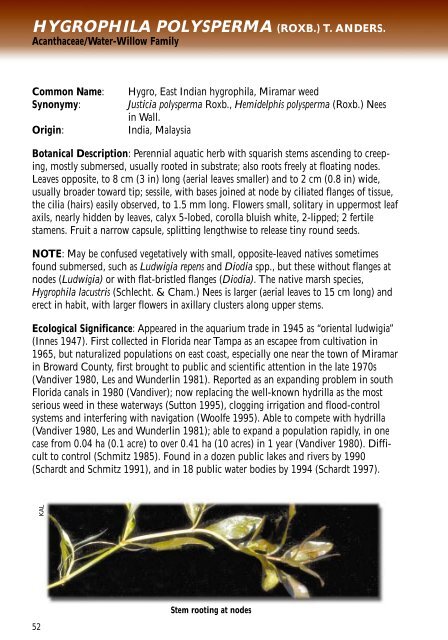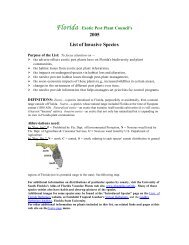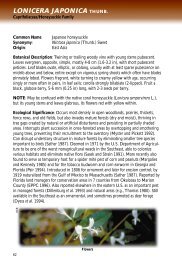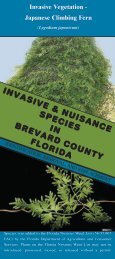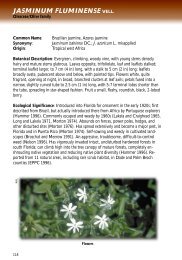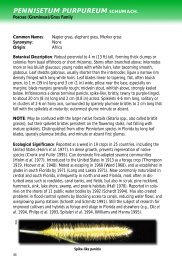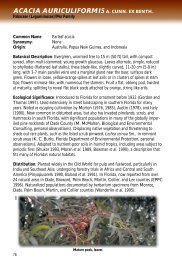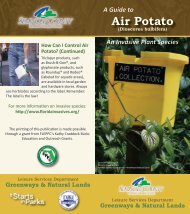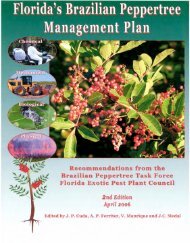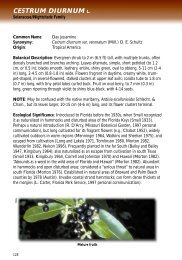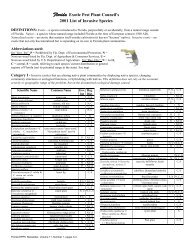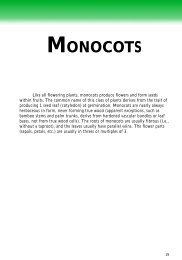DICOTS - Florida Exotic Pest Plant Council
DICOTS - Florida Exotic Pest Plant Council
DICOTS - Florida Exotic Pest Plant Council
You also want an ePaper? Increase the reach of your titles
YUMPU automatically turns print PDFs into web optimized ePapers that Google loves.
Hygrophila polysperma (Roxb.) T. Anders.<br />
Acanthaceae/Water-Willow Family<br />
Common Name: Hygro, East Indian hygrophila, Miramar weed<br />
Synonymy: Justicia polysperma Roxb., Hemidelphis polysperma (Roxb.) Nees<br />
in Wall.<br />
Origin: India, Malaysia<br />
Botanical Description: Perennial aquatic herb with squarish stems ascending to creeping,<br />
mostly submersed, usually rooted in substrate; also roots freely at floating nodes.<br />
Leaves opposite, to 8 cm (3 in) long (aerial leaves smaller) and to 2 cm (0.8 in) wide,<br />
usually broader toward tip; sessile, with bases joined at node by ciliated flanges of tissue,<br />
the cilia (hairs) easily observed, to 1.5 mm long. Flowers small, solitary in uppermost leaf<br />
axils, nearly hidden by leaves, calyx 5-lobed, corolla bluish white, 2-lipped; 2 fertile<br />
stamens. Fruit a narrow capsule, splitting lengthwise to release tiny round seeds.<br />
NOTE: May be confused vegetatively with small, opposite-leaved natives sometimes<br />
found submersed, such as Ludwigia repens and Diodia spp., but these without flanges at<br />
nodes (Ludwigia) or with flat-bristled flanges (Diodia). The native marsh species,<br />
Hygrophila lacustris (Schlecht. & Cham.) Nees is larger (aerial leaves to 15 cm long) and<br />
erect in habit, with larger flowers in axillary clusters along upper stems.<br />
Ecological Significance: Appeared in the aquarium trade in 1945 as “oriental ludwigia”<br />
(Innes 1947). First collected in <strong>Florida</strong> near Tampa as an escapee from cultivation in<br />
1965, but naturalized populations on east coast, especially one near the town of Miramar<br />
in Broward County, first brought to public and scientific attention in the late 1970s<br />
(Vandiver 1980, Les and Wunderlin 1981). Reported as an expanding problem in south<br />
<strong>Florida</strong> canals in 1980 (Vandiver); now replacing the well-known hydrilla as the most<br />
serious weed in these waterways (Sutton 1995), clogging irrigation and flood-control<br />
systems and interfering with navigation (Woolfe 1995). Able to compete with hydrilla<br />
(Vandiver 1980, Les and Wunderlin 1981); able to expand a population rapidly, in one<br />
case from 0.04 ha (0.1 acre) to over 0.41 ha (10 acres) in 1 year (Vandiver 1980). Difficult<br />
to control (Schmitz 1985). Found in a dozen public lakes and rivers by 1990<br />
(Schardt and Schmitz 1991), and in 18 public water bodies by 1994 (Schardt 1997).<br />
KAL<br />
52<br />
Stem rooting at nodes


